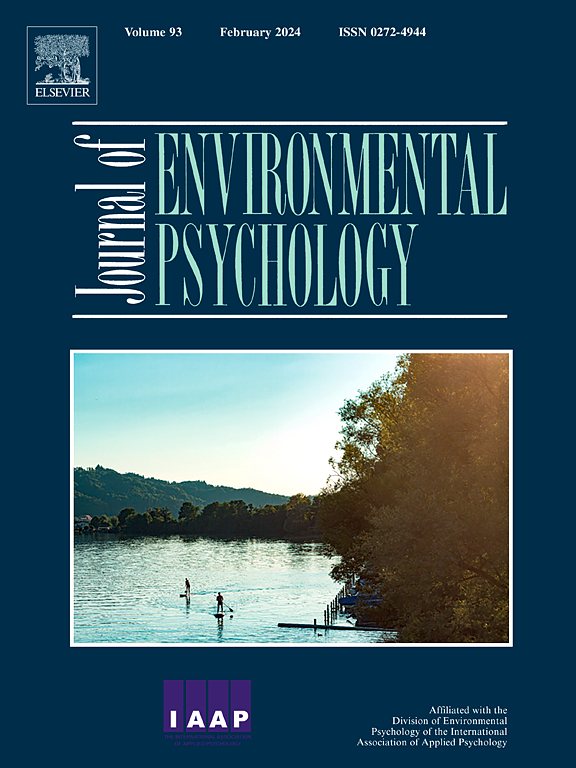Visions of Tomorrow: Emotional drivers of climate change mitigation and adaptation intentions
IF 7
1区 心理学
Q1 ENVIRONMENTAL STUDIES
引用次数: 0
Abstract
This research explores the effects of exposure to utopian vs. dystopian vs. neutral visions of the future (with regards to environmental sustainability or unsustainability) on individuals’ intentions to mitigate and to adapt to climate change, through emotional arousal. In two pre-registered experimental studies, participants were randomly assigned to read about a utopian, dystopian, or neutral vision of future society. In Study 1 (N = 303), behavioural intentions, emotional responses to the scenario (fear, anger, sadness, hope and happiness), the ability to imagine a positive future, and beliefs about sustainable futures were assessed. Results indicated no direct effects of the visions on behavioural intentions, future imagination, or beliefs. However, exposure to a utopian (vs. neutral) and a dystopian (vs. neutral) vision indirectly affect both mitigation and adaptation intentions through feelings of hope (increased and decreased, respectively). Study 2 (N = 401) partially replicated the findings of Study 1. As expected, exposure to a utopian and a dystopian vision indirectly affect mitigation intentions through feelings of hope (increased and decreased, respectively). Adaptation intentions, however, were predicted by happiness rather than hope. These findings highlight the role of positive emotions in promoting pro-environmental intentions and suggest that positive emotions can drive climate actions. While negative emotions like fear, sadness and anger were correlated with intentions, they did not predict behaviours in path analysis. This research underscores the potential of using emotionally engaging future visions to foster sustainable behaviours.
未来愿景:减缓和适应气候变化意图的情感驱动因素
本研究探讨了暴露于乌托邦、反乌托邦、中性的未来愿景(关于环境可持续性或不可持续性)对个人通过情绪唤醒来缓解和适应气候变化的意图的影响。在两项预先登记的实验研究中,参与者被随机分配阅读关于未来社会的乌托邦、反乌托邦或中性愿景。在研究1 (N = 303)中,评估了行为意图、对场景的情绪反应(恐惧、愤怒、悲伤、希望和幸福)、想象积极未来的能力以及对可持续未来的信念。结果表明,视觉对行为意图、未来想象或信念没有直接影响。然而,暴露于乌托邦(相对于中性)和反乌托邦(相对于中性)的愿景中,通过希望的感觉(分别增加和减少)间接影响缓解和适应意图。研究2 (N = 401)部分重复了研究1的结果。正如预期的那样,接触乌托邦和反乌托邦愿景会通过希望感间接影响缓解意图(分别增加和减少)。然而,适应意向是由快乐而不是希望来预测的。这些发现强调了积极情绪在促进亲环境意图方面的作用,并表明积极情绪可以推动气候行动。虽然恐惧、悲伤和愤怒等负面情绪与意图相关,但它们并不能预测路径分析中的行为。这项研究强调了使用情感参与的未来愿景来培养可持续行为的潜力。
本文章由计算机程序翻译,如有差异,请以英文原文为准。
求助全文
约1分钟内获得全文
求助全文
来源期刊

Journal of Environmental Psychology
Multiple-
CiteScore
10.60
自引率
8.70%
发文量
140
审稿时长
62 days
期刊介绍:
The Journal of Environmental Psychology is the premier journal in the field, serving individuals in a wide range of disciplines who have an interest in the scientific study of the transactions and interrelationships between people and their surroundings (including built, social, natural and virtual environments, the use and abuse of nature and natural resources, and sustainability-related behavior). The journal publishes internationally contributed empirical studies and reviews of research on these topics that advance new insights. As an important forum for the field, the journal publishes some of the most influential papers in the discipline that reflect the scientific development of environmental psychology. Contributions on theoretical, methodological, and practical aspects of all human-environment interactions are welcome, along with innovative or interdisciplinary approaches that have a psychological emphasis. Research areas include: •Psychological and behavioral aspects of people and nature •Cognitive mapping, spatial cognition and wayfinding •Ecological consequences of human actions •Theories of place, place attachment, and place identity •Environmental risks and hazards: perception, behavior, and management •Perception and evaluation of buildings and natural landscapes •Effects of physical and natural settings on human cognition and health •Theories of proenvironmental behavior, norms, attitudes, and personality •Psychology of sustainability and climate change •Psychological aspects of resource management and crises •Social use of space: crowding, privacy, territoriality, personal space •Design of, and experiences related to, the physical aspects of workplaces, schools, residences, public buildings and public space
 求助内容:
求助内容: 应助结果提醒方式:
应助结果提醒方式:


